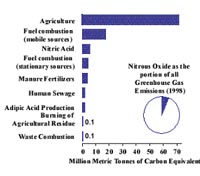| |
Main Listing
|
|
The Future of Nitrous Oxide
Introduction
Nitrous oxide (N2O) is a colorless greenhouse gas that is produced both naturally – from a biological sources in soil and water – and by a variety of human activities including agriculture, industry and waste management. While nitrous oxide emissions are much lower than CO2 emissions, N2O is some 310 times more effective than carbon dioxide as a greenhouse gas, molecule for molecule and its increasing release into the atmosphere is of concern.
Biological Sources of Nitrous Oxide

Nitrous oxide concentrations in the atmosphere have increased by approximately 13 percent in the last two centuries. (From: EPA) |
Nitrous oxide originates naturally as a result of bacterial action, which converts nitrate ions to nitrogen compounds that contain less oxygen. The bacteria use the oxygen gained in this process to burn carbon which provides the energy for reproduction and maintenance. The stripping of oxygen from nitrate is called “denitrification.” Human agricultural activities, such as application of fertilizers and livestock manure on croplands and pasture, directly add to the amount of nitrogen available to be converted to N2O by bacterial action.
River runoff rich in nitrate from agriculture indirectly leads to the expansion of oxygen-poor environments in many places, such as the Gulf of Mexico, as it leads to fertilization of near-shore surface waters. This fertilizer helps increase coastal production of microscopic algae, which in turn leads to increased settling of organic matter. This organic matter decays, (that is, bacterial oxidizes it), and this uses up oxygen dissolved in the water. When this oxygen becomes less plentiful, bacteria switch to nitrate to oxidize the organic matter. The partial stripping of oxygen from nitrate produces nitrous oxide.
Other Sources

1998 sources of N 2O. The use of nitrogen fertilizer in agricultural soil management is by for the most significant anthropogenic source of N 2O. (From: EPA) |
Other sources of N2O include fuel combustion, industrial production of acids that contain nitrogen, burning of agricultural residue, waste combustion, and human sewage in wastewater treatment systems.
All sources of nitrous oxide emissions are increasing, with the exception of adipic acid production. There is no reason to think that sources of nitrogen will decrease in the near future. It fact, it may be anticipated that warming of surface waters in a global warming scenario (which decreases the amount of oxygen that can be held in solution) combined with continued nitrogen fertilization will lead to a steady increase the flux of nitrous oxide to the atmosphere from biological sources.
|
|



